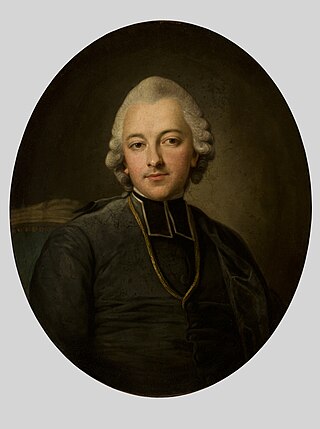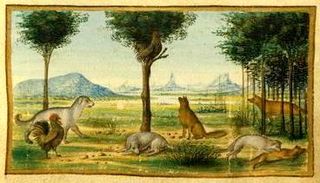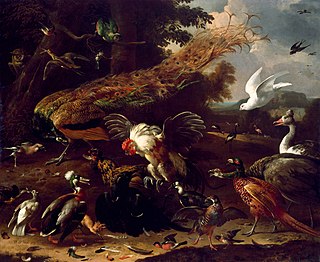
Ivan Andreyevich Krylov is Russia's best-known fabulist and probably the most epigrammatic of all Russian authors. Formerly a dramatist and journalist, he only discovered his true genre at the age of 40. While many of his earlier fables were loosely based on Aesop's and La Fontaine's, later fables were original work, often with a satirical bent.

The hooded crow, also called the scald-crow or hoodie, is a Eurasian bird species in the genus Corvus. Widely distributed, it is found across Northern, Eastern, and Southeastern Europe, as well as parts of the Middle East. It is an ashy grey bird with black head, throat, wings, tail, and thigh feathers, as well as a black bill, eyes, and feet. Like other corvids, it is an omnivorous and opportunistic forager and feeder.

Aesop's Fables, or the Aesopica, is a collection of fables credited to Aesop, a slave and storyteller who lived in ancient Greece between 620 and 564 BCE. Of varied and unclear origins, the stories associated with his name have descended to modern times through a number of sources and continue to be reinterpreted in different verbal registers and in popular as well as artistic media.

Fables and Parables, by Ignacy Krasicki (1735–1801), is a work in a long international tradition of fable-writing that reaches back to antiquity.

Eating crow is a colloquial idiom, used in some English-speaking countries, that means humiliation by admitting having been proven wrong after taking a strong position. The crow is a carrion-eater that is presumably repulsive to eat in the same way that being proven wrong might be emotionally hard to swallow. The exact origin of the idiom is unknown, but it probably began with an American story published around 1850 about a dim-witted New York farmer.
A wolf in sheep's clothing is an idiom from Jesus's Sermon on the Mount as narrated in the Gospel of Matthew. It warns against individuals who play a duplicitous role. The gospel regards such individuals as dangerous.

The Fox and the Crow is one of Aesop's Fables, numbered 124 in the Perry Index. There are early Latin and Greek versions and the fable may even have been portrayed on an ancient Greek vase. The story is used as a warning against listening to flattery.

The Tortoise and the Birds is a fable of probable folk origin, early versions of which are found in both India and Greece. There are also African variants. The moral lessons to be learned from these differ and depend on the context in which they are told.

The Morall Fabillis of Esope the Phrygian is a work of Northern Renaissance literature composed in Middle Scots by the fifteenth century Scottish makar, Robert Henryson. It is a cycle of thirteen connected narrative poems based on fables from the European tradition. The drama of the cycle exploits a set of complex moral dilemmas through the figure of animals representing a full range of human psychology. As the work progresses, the stories and situations become increasingly dark.

A shepherd or sheepherder is a person who tends, herds, feeds, or guards flocks of sheep. Shepherd derives from Old English sceaphierde. Shepherding is one of the world's oldest occupations; it exists in many parts of the globe, and it is an important part of pastoralist animal husbandry.

The Wolf and the Crane is a fable attributed to Aesop that has several eastern analogues. Similar stories have a lion instead of a wolf, and a stork, heron or partridge takes the place of the crane.

The Cock, the Dog and the Fox is one of Aesop's Fables and appears as number 252 in the Perry Index. Although it has similarities with other fables where a predator flatters a bird, such as The Fox and the Crow and Chanticleer and the Fox, in this one the cock is the victor rather than victim. There are also Eastern variants of this story.

The Walnut Tree is one of Aesop's fables and numbered 250 in the Perry Index. It later served as a base for a misogynistic proverb, which encourages the violence against walnut trees, asses and women.
The Hawk and the Nightingale is one of the earliest fables recorded in Greek and there have been many variations on the story since Classical times. The original version is numbered 4 in the Perry Index and the later Aesop version, sometimes going under the title "The Hawk, the Nightingale and the Birdcatcher", is numbered 567. The stories began as a reflection on the arbitrary use of power and eventually shifted to being a lesson in the wise use of resources.
The Gourd and the Palm-tree is a rare fable of West Asian origin that was first recorded in Europe in the Middle Ages. In the Renaissance a variant appeared in which a pine took the palm-tree's place and the story was occasionally counted as one of Aesop's Fables.

The Bird in Borrowed Feathers is a fable of Classical Greek origin usually ascribed to Aesop. It has existed in numerous different versions between that time and the Middle Ages, going by various titles and generally involving members of the corvid family. The lesson to be learned from it has also varied, depending on the context in which it was told. Several idioms derive from the fable.
Adae Kese Festival is an important albeit rare celebration among the Ashantis in Ghana. There are two main periods for this celebration: one is Awukudae, and the other is Akwasidae. It glorifies the achievements of the Asante kingdom. It was first celebrated to the achievement of statehood of the people, after the war that the Ashantis had their independence, in the Battle of Feyiase which they fought against the people of Denkyira. It is also the occasion when the purification ceremony of Odwira is performed at the burial shrines of ancestral spirits. Generally, this coincides with the harvest season of yam and hence the ritual was also called the "Yam custom" by Europeans. It is celebrated every two weeks by the people in accordance with the calendar of the Akans based on the cycle of forty-two days and nine months in their calendar. The festival is mostly held to climax celebrations of specific achievements and milestones of the people of the Ashanti kingdom. The festival is a day of rest so it is forbidden to work on that day.

The Dog and the Sheep is one of Aesop's Fables and is numbered 478 in the Perry Index. Originally its subject was the consequence of bearing false witness. However, longer treatments of the story during the Middle Ages change the focus to deal with perversions of justice by the powerful at the expense of the poor. It has sometimes been alternatively titled The Wolf, the Dog and the Sheep in order to distinguish it from the fable of the dispute between the sheep and the dog that guards them.

The Wolf and the Shepherds is ascribed to Aesop's Fables and is numbered 453 in the Perry Index. Although related very briefly in the oldest source, some later authors have drawn it out at great length and moralised that perceptions differ according to circumstances.















